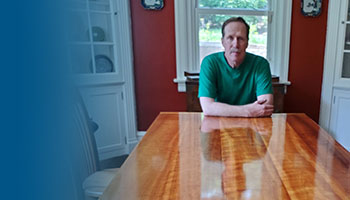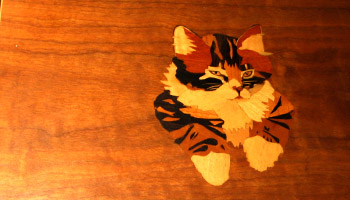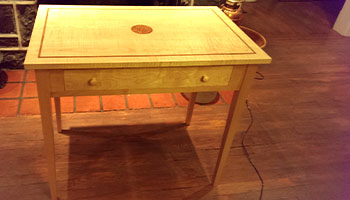HOW CAN WE HELP YOU? Call 1-800-TRY-CHOP
In This Section
Woodworking Craftsmanship Takes Skill, Risk, and Lumberyard Etiquette

Dr. Ike Eisenlohr in his dining room with an 8-foot trestle table he made out of cherry.
mccannn [at] chop.edu (By Nancy McCann)
Editor's Note: Hello, summer! And welcome back to our seasonal Off Campus series where we share the off campus exploits and adventures of our Research Institute colleagues. Read along to learn what your co-workers do to de-stress and reset once they leave Osler Circle or close the door to their home offices.
With a love of woodworking since an early age, learned from his father in the basement of their family's West Philadelphia house, Laurence "Ike" Eisenlohr, VMD, PhD, spends many of his off campus hours in the garage of his home today — not tinkering with polished cars, but planing, sawing, and refining raw wood into handcrafted, heirloom-quality furniture for his family.
"My wife knew from the start there wouldn't be any cars in our garage," he said, laughing.
Four-wheeled vehicles may be missing, but in their place is a variety of power machinery: a table saw, bandsaw, chop saw, router table, and a plethora of hand tools.
"The power tools get me on the map," Dr. Eisenlohr said, "and then I navigate a lot of the finishing with hand tools."
Acknowledging the lethalness of this type of machinery, Dr. Eisenlohr said safety is absolutely critical when working with it. He's a disciple of "measure twice, cut once," and he wears plenty of gear: goggles, noise-cancelling headphones, and a mask because sawdust, especially hardwood sawdust, is unhealthy to breath.
"I try not to wreck my body as I'm working with the wood," he said.
So why does Dr. Eisenlohr, an infectious disease/immune response researcher by occupation, risk limb and lung for a hobby?
"I really like the idea the pieces I make will get passed down," said Dr. Eisenlohr, who is also on faculty in the Perelman School of Medicine at the University of Pennsylvania. "My kids will have something they can own. I walk through the house, and I see all the stuff that I made — it's a satisfying feeling," he said. "They all have defects. They all have problems. And for a while, the only thing you see are the mistakes you made. But then, you forget them and you just look at the whole piece and you go, 'You know, that turned out alright.'"
Lumberyard Etiquette

The lid of a jewelry box made with cherry veneer and inlaid with many different veneer woods. The box was a gift for Dr. Eisenlohr’s daughter.
With a world-famous hardwood lumberyard within driving distance from his workshop, Dr. Eisenlohr has his pick of material for his projects. From American grown cherry, maple, and walnut to rare, exotic woods like ebony and bubinga. Being a responsible consumer, he uses the rare woods sparingly, as some come from parts of the world where the wood is not harvested in a sustainable way.
After Dr. Eisenlohr sketches out his project and figures out how much wood is needed, it's time to hit the lumberyard. Whether it's an 8-foot trestle table or an 11-inch jewelry box, the same rules apply. In the lumberyard, the woodworkers follow an unspoken etiquette: Replace the unwanted boards. The wood, piled-high in stacks, is rough; none of it is smooth and shining until it goes through the planer. So as the boards are pulled out one-by-one in search of the perfect piece, they can't be left strewn all over the floor.
"You pick your wood out, and then you very carefully return the other boards to the stack," Dr. Eisenlohr said. "You have to know what you're doing. You have to be able to see the grain and how it's going to work when you're finished. I always like that day, getting my lumber, securing it to the roof rack, and bringing it home. Then it has to sit at home for a month or so because wood breathes, and it takes in moisture. You have to let it equilibrate."
The Best Day

Maple writing desk with quilted maple top and intricate knot inlay, made of mahogany, maple, and walnut veneers.
The project progresses day-by-day, from running the boards through the planer in order to get them "nice and flat," to sawing and putting the pieces together.
"For several days, I'm just cutting out the wood and putting it together," Dr. Eisenlohr said, "and then I get to some point of the assembly where I go, 'That's it!' At that point, I'm over the hump. I can see it, and that's a really satisfying part. People that do this — they know what I mean."
Then he preps the surfaces to make sure they're all "polished and cleaned, well-sanded, and nice and smooth," in order to put the finish on, which for Dr. Eisenlohr is not stain, but oil or urethane, as he likes to keep the natural wood.
"When the grain takes up the finish, it really jumps to life," Dr. Eisenlohr enthused. "It's like nothing you've ever seen. This is the most satisfying. All the raw wood — like the flaming cherry in this dining table — when the finish goes on, and the grain jumps out, it's like POW!"
Skill and Risk
Dr. Eisenlohr gravitates toward the difficult techniques of woodworking, such as inlaid wood, dovetails, and butterflies, with surgeon-like precision. Perhaps this is because in veterinarian school he considered becoming a surgeon before choosing a career in research. He insets paper-thin veneers into finished pieces of furniture with a scalpel, glue, patience — and a good light with a magnifying glass.
"For me, this is craftsmanship," he said. "It takes skill. It goes beyond just cutting a couple of pieces of wood and screwing them together. I just put my headphones on and listen to podcasts. Woodworking is an outlet for me."
But it's also terrifying, Dr. Eisenlohr said, since he could ruin a completed piece as he painstakingly tries to insert the banding or inlaid veneers.
"If you're not careful, if you don't do it just right, all that work goes down the drain," Dr. Eisenlohr warns. "But the beautiful thing about wood is sometimes you can repair it. And if you totally wreck it, you get some more wood and try it again. Yes, it's time lost, but you learn something. I can say, I haven't wrecked something twice."
When an Idea Strikes
Dr. Eisenlohr gets decent science ideas while he builds his projects because much of the work doesn't require maximum concentration, so an idea can "easily pop in," he explained. "It catches you at a moment when your inhibitory circuits are down, and all of a sudden the idea can come in and — BOOM! Whenever that happens, I drop everything and write it down."
Writing a science paper, he said, isn't so very different from woodworking.
"You have these pieces of data; you've got a story, and you have to put them together in a finished piece. They have to be harmonious, and so there's some creativity involved. Science often doesn't turn out the way you anticipate — but wood has a chance of doing that."


